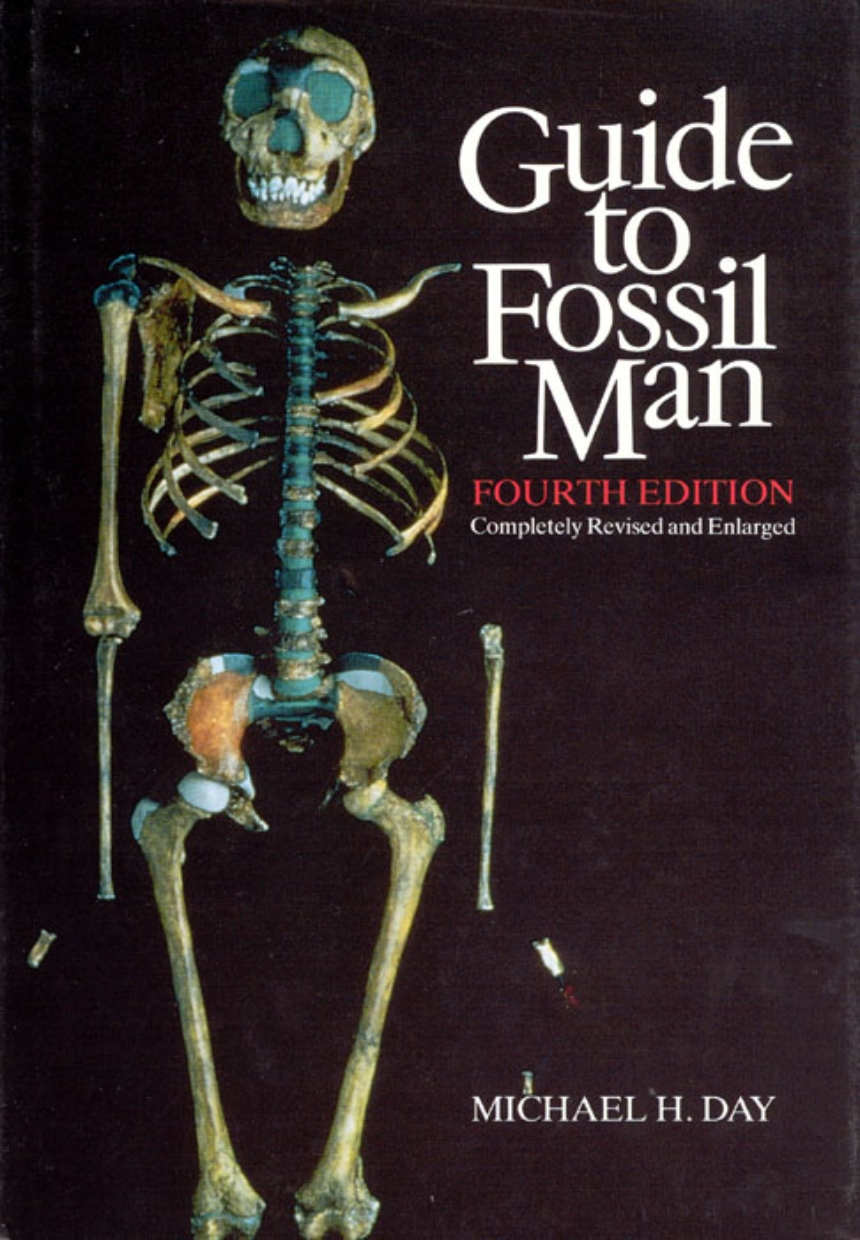Guide to Fossil Man
4th Edition
Michael H. Day’s Guide to Fossil Man is the standard reference work on hominid remains found at the major palaeolithic sites throughout the world. This fourth edition now includes details of fifteen new sites, as well as new evidence from thirty-four previously known sites featured in earlier editions of the book.
Day begins with an introduction to the anatomy of human fossils. He then describes the forty-nine sites in Europe, the Near East, Africa, the Middle East, Asia, and Oceania that have yielded the most significant information on the development of hominid species and the appearance of early man. Grouped geographically, each site description includes data on the hominid remains, other finds such as tools and animal bones, the local geology and contemporary geomorphology and ecology, and dating and other references. Sites featured for the first time in this edition include Kow Swamp and Mungo in Australia; Dali and Maba in China; and West Turkana in Kenya, which contained the almost complete skeleton of a boy determined to be 1,600,000 years old.
Short essays on problems associated with neandertal, australpithecine, and Homo erectus remains are included, as well as a glossary, a geological time scale, charts and comprehensive illustrations. Day’s Guide to Fossil Man is invaluable not only for working palaeontologists, palaeolithic archaeologists, and physical anthropologists, but also for anyone interested in human evolution.
Day begins with an introduction to the anatomy of human fossils. He then describes the forty-nine sites in Europe, the Near East, Africa, the Middle East, Asia, and Oceania that have yielded the most significant information on the development of hominid species and the appearance of early man. Grouped geographically, each site description includes data on the hominid remains, other finds such as tools and animal bones, the local geology and contemporary geomorphology and ecology, and dating and other references. Sites featured for the first time in this edition include Kow Swamp and Mungo in Australia; Dali and Maba in China; and West Turkana in Kenya, which contained the almost complete skeleton of a boy determined to be 1,600,000 years old.
Short essays on problems associated with neandertal, australpithecine, and Homo erectus remains are included, as well as a glossary, a geological time scale, charts and comprehensive illustrations. Day’s Guide to Fossil Man is invaluable not only for working palaeontologists, palaeolithic archaeologists, and physical anthropologists, but also for anyone interested in human evolution.
448 pages | 133 illustrations | 6.75 x 9.50 | © 1986
Anthropology: Physical Anthropology
Biological Sciences: Paleobiology, Geology, and Paleontology
Table of Contents
List of Illustrations
Introduction to the First Edition
Introduction to the Fourth Edition
Acknowledgments
Part I - The Anatomy of Fossil Man
Bones
Normal Skeletal Variation
Sexual Variation
Age Variation
Age Variation
Teeth
Footprints
Nomenclature and Taxonomy
Part II - The Fossil Hominids
Use of the guide
EUROPE
Great Britain
The Swanscombe Skull Fragments
The Pontnewydd Remains
France
The La Chapelle-aux-Saints Skeleton
The La Ferrassie Skeletons
The Cro-Magnon Remains
The Arago Remains
The St. Césaire Skeleton
Germany
The Bilzingsleben Remains
The Neandertal Skeleton
The Mauer Mandible
The Steinheim Calvaria
Yugoslavia
The Krapina Remains
Greece
The Petralona Cranium
Hungary
The Vértesszollos Remains
NEAR EAST
Israel
The Tabun Remains
The Skhul Remains
The Jebel Qafzeh Remains
The Amud Remains
Iraq
The Shanidar Remains
NORTHWEST AFRICA
Algeria
The Ternifine Remains
Morocco
The Jebel Ighoud Remains
The Salé Calvaria
EAST AFRICA
Tanzania
The Olduvai Remains
The Laetoli Remains
Kenya
The Koobi Fora Remains
The Baringo Remains
The West Turkana Skeleton
Ethiopia
The Omo Remains
The Hadar Remains
The Middle Awash Remains
SOUTHERN AFRICA
Zambia
The Kabwe (Rhodesian) Remains
Bophuthatswana
The Taung Skull
South Africa
The Sterkfontein Remains
The Kromdraai Remains
The Swartkrans Remains
The Makapansgat Remains
The Florisbad Skull
The Border Cave Remains
THE FAR EAST
Java
The Trinil Remains
The Sangiran Remains
The Ngandong Remains
The Sambungmachan Calvaria
China
The Perking Remains
The Lantian Remains
The Hexian Calvaria
The Dali Cranium
The Maba Calotte
OCEANIA
Australia
The Mungo Remains
The Kow Swamp Remains
Part III - Essays on Fossil Man
The Australopithecine Problem
The Homo erectus Problem
The Neandertal Problem
Geological and Palaeomagnetic Time Scales
Glossary
Index
Introduction to the First Edition
Introduction to the Fourth Edition
Acknowledgments
Part I - The Anatomy of Fossil Man
Bones
Normal Skeletal Variation
Sexual Variation
Age Variation
Age Variation
Teeth
Footprints
Nomenclature and Taxonomy
Part II - The Fossil Hominids
Use of the guide
EUROPE
Great Britain
The Swanscombe Skull Fragments
The Pontnewydd Remains
France
The La Chapelle-aux-Saints Skeleton
The La Ferrassie Skeletons
The Cro-Magnon Remains
The Arago Remains
The St. Césaire Skeleton
Germany
The Bilzingsleben Remains
The Neandertal Skeleton
The Mauer Mandible
The Steinheim Calvaria
Yugoslavia
The Krapina Remains
Greece
The Petralona Cranium
Hungary
The Vértesszollos Remains
NEAR EAST
Israel
The Tabun Remains
The Skhul Remains
The Jebel Qafzeh Remains
The Amud Remains
Iraq
The Shanidar Remains
NORTHWEST AFRICA
Algeria
The Ternifine Remains
Morocco
The Jebel Ighoud Remains
The Salé Calvaria
EAST AFRICA
Tanzania
The Olduvai Remains
The Laetoli Remains
Kenya
The Koobi Fora Remains
The Baringo Remains
The West Turkana Skeleton
Ethiopia
The Omo Remains
The Hadar Remains
The Middle Awash Remains
SOUTHERN AFRICA
Zambia
The Kabwe (Rhodesian) Remains
Bophuthatswana
The Taung Skull
South Africa
The Sterkfontein Remains
The Kromdraai Remains
The Swartkrans Remains
The Makapansgat Remains
The Florisbad Skull
The Border Cave Remains
THE FAR EAST
Java
The Trinil Remains
The Sangiran Remains
The Ngandong Remains
The Sambungmachan Calvaria
China
The Perking Remains
The Lantian Remains
The Hexian Calvaria
The Dali Cranium
The Maba Calotte
OCEANIA
Australia
The Mungo Remains
The Kow Swamp Remains
Part III - Essays on Fossil Man
The Australopithecine Problem
The Homo erectus Problem
The Neandertal Problem
Geological and Palaeomagnetic Time Scales
Glossary
Index
